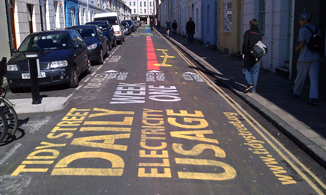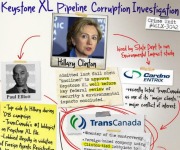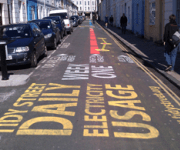 Tidy Street.Jon Bird is a master of getting people to change their ways. A senior research associate at University College London who divides his time between the computer science and psychology departments, he recently designed a machine that helps beginners learn to play the violin by giving them the magic buzzer treatment whenever they make a mistake.
Tidy Street.Jon Bird is a master of getting people to change their ways. A senior research associate at University College London who divides his time between the computer science and psychology departments, he recently designed a machine that helps beginners learn to play the violin by giving them the magic buzzer treatment whenever they make a mistake.
“I had a vested interest,” Bird says. “My son had just taken up the violin. It normally takes 700 hours to learn. I thought, ‘If we could just cut back a little on that screeching … ‘”
Bird and his cronies also helped design a genius shopping cart that helps you find local, nutritious food. But when it comes to teaching people to conserve energy, he may have met his match.
Last spring, Bird and his colleagues enlisted a group of 17 households on Tidy Street in Brighton, a seaside town south of London, who agreed to record their electricity use over time. To make their progress (or lack thereof) plainly visible, he enlisted artists from the nearby Goldsmiths College to stencil a giant graph down the street. A red line down the center of the graph indicated the city’s average electricity usage. The Tidy Street residents’ use was charted with a yellow line and stars, so residents could see how they stacked up to the rest of town.
When they started, the residents of Tidy Street were about average for Brighton, but within three weeks, they had reduced their electricity use by 15 percent. Bird credits the change to the fact that residents were 1. Paying attention (“I always used to fill up my kettle to the top, but having seen how much extra power that uses, I’m careful to just boil what I need,” 70-year-old Ruth Goodall told the Guardian.), 2. getting some public notice for their efforts, both from the press and from inquisitive passersby. Each time their performance improved, they felt a little community pride. When they slipped back, the giant public display gave them a variation on the magic buzzer treatment.
That much of the story is told, in heartwarming detail, in the new film Urbanized, by Gary Hustwit. But from there, the tale of Tidy Street gets more complicated.
“After three weeks, we’d filled up the entire road,” Bird says. “But we asked the residents to continue the experiment.” A few households bowed out, but 80 percent agreed to carry on. Six weeks into the experiment, however, they were down to just 50 percent participation. And now, six months in, only three households are checking their meters each day. Of those, only two have kept their electricity use down. (The last one dutifully records her electricity use, but hasn’t reduced it substantially. Go figure.)
“If you give people feedback on energy use, it does have the effect of reducing energy usage in the short-term,” Bird says. “What is trickier is, how do you get sustained sustainable behavior? Anybody who tells you they know how to do that, maybe hasn’t done it.”
Bird’s work falls within a growing body of what is known as “nudge” theory, which looks at ways to use behavioral psychology to encourage citizens to make smart choices. It was made popular by Cass Sunstein and Richard Thaler in their 2009 book, Nudge: Improving Decisions About Health, Wealth, and Happiness. (Sunstein has since become President Obama’s regulatory czar, while Thaler has advised the British government’s new “nudge” unit.)
If changing human behavior is key to solving environmental conundrums such as climate change, this line of thinking is key. But the Tidy Street Project offers a taste of just how tricky this whole business can be.
“There’s a difference between awareness and behavior,” Bird says. “We’ve got the awareness, but haven’t quite got the motivation … Why is it that gyms have more membership than capacity? Most people don’t go. That’s human beings.”
An attempt to replicate the Tidy Street experiment on Bainbridge Island, off of Seattle, was a flop. Bird says that the suburban island streets just didn’t get enough foot traffic to spark questions and make the residents feel ownership of the project.
But another, similar trick has netted results. Every two months, every household on the island (except for those in a control group) gets and electric bill that shows how they compare to their neighbors. “When they come out, it’s the talk of the ferry,” Bird says. The experiment has produced about a 3 percent reduction in electricity use. (A similar experiment in California produced impressive results simply by adding either a happy or sad face on residents’ electric bills, depending on whether they were above or below the average.)
“Social norms marketing” — providing people with the data to compare themselves to their neighbors — can inspire change, yes, but Bird hastens to add that it can work in both directions. He describes campaigns aimed at reducing drinking among college students by publicizing alarming statistics about the average alcohol consumption on campus. “What they find is that the students who drink more than the norm drink less,” Bird says, “but often students that drink less drink more.”
It’s called the “boomerang effect,” and it certainly adds credence to the argument that our best bet for saving the planet is to build machines that can outsmart us. Forget about these foolish humans. We might have to engineer our way out of this mess.
Bird understands the argument, but still begs to differ. “The most efficient light bulb is one that is switched off,” he says. “Behavior is messy, motivations are messy, but they’re still a crucial part of the puzzle.”



